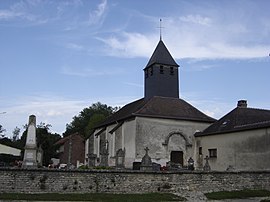world.wikisort.org - France
Juvanzé (French pronunciation: [ʒyvɑ̃ze]) is a commune in the Aube department in the Grand Est region in north-central France.
This article may be expanded with text translated from the corresponding article in French. (December 2008) Click [show] for important translation instructions.
|
Juvanzé | |
|---|---|
Commune | |
 The church in Juvanzé | |
Location of Juvanzé  | |
 Juvanzé  Juvanzé | |
| Coordinates: 48°19′03″N 4°33′39″E | |
| Country | France |
| Region | Grand Est |
| Department | Aube |
| Arrondissement | Bar-sur-Aube |
| Canton | Brienne-le-Château |
| Government | |
| • Mayor (2020–2026) | Gérard Bergerat[1] |
| Area 1 | 4.94 km2 (1.91 sq mi) |
| Population | 35 |
| • Density | 7.1/km2 (18/sq mi) |
| Time zone | UTC+01:00 (CET) |
| • Summer (DST) | UTC+02:00 (CEST) |
| INSEE/Postal code | 10183 /10140 |
| 1 French Land Register data, which excludes lakes, ponds, glaciers > 1 km2 (0.386 sq mi or 247 acres) and river estuaries. | |
Juvanzé is a small, isolated hamlet with about 20 houses and a population of 34 full-time residents, with upwards to about 50 residents in total during the summers when the mainly Parisien second-home owners flock to its quiet tranquility with their families. Originally called "Jouvanzé", this village, situated between Unienville and Trannes, has traces dating back to the High Middle Ages, as evident in a Medieval statue (the original statue recently moved to the Louvre Museum in Paris) adorning the river side bank housed by a very small stone chapel. The village was founded by the Abbey of Beaulieu in the 12th century for the mills which had been constructed there. The land next to Juvanzé is intersected by a Roman road which follows a North-South trajectory linking Langres to Chalôns.
Climate
Juvanzé is subject to typically harsh winters, with temperatures occasionally falling to -20° Celsius, while in the summertime temperatures can reach an almost-blistering 40 °C.
Economy
Juvanzé supplies its own electrical power thanks to a hydroelectric generator built on the river. Juvanzé is home to many domestic farm animals providing the residents with such nourishment as meat, milk, and eggs.
Population
| Year | Pop. | ±% |
|---|---|---|
| 1962 | 29 | — |
| 1968 | 36 | +24.1% |
| 1975 | 32 | −11.1% |
| 1982 | 22 | −31.2% |
| 1990 | 27 | +22.7% |
| 1999 | 37 | +37.0% |
| 2008 | 31 | −16.2% |
Tourism
Lake Juvanzé, a beautifully situated shallow landlocked lake has recently become a popular destination for carp fishing enthusiasts, and is situated directly behind the village across the river Aube.[3]
See also
- Communes of the Aube department
- Parc naturel régional de la Forêt d'Orient
References
- "Répertoire national des élus: les maires" (in French). data.gouv.fr, Plateforme ouverte des données publiques françaises. 13 September 2022.
- "Populations légales 2019". The National Institute of Statistics and Economic Studies. 29 December 2021.
- Wake Up Fishing.com Archived 2009-04-07 at the Wayback Machine
На других языках
[de] Juvanzé
Juvanzé (1793 und 1801 noch mit den Schreibweisen Juvanzey und Juvauzé[1]) ist eine französische Gemeinde mit 35 Einwohnern (Stand: 1. Januar 2019) im Département Aube in der Region Grand Est (bis 2015 Champagne-Ardenne). Die Gemeinde gehört zum Arrondissement Bar-sur-Aube und zum 2014 gegründeten Gemeindeverband Lacs de Champagne. Die Bewohner nennen sich Vandois.- [en] Juvanzé
[ru] Жюванзе
Жюванзе́ (фр. Juvanzé) — коммуна во Франции, находится в регионе Шампань — Арденны. Департамент — Об. Входит в состав кантона Вандёвр-сюр-Барс. Округ коммуны — Бар-сюр-Об.Другой контент может иметь иную лицензию. Перед использованием материалов сайта WikiSort.org внимательно изучите правила лицензирования конкретных элементов наполнения сайта.
WikiSort.org - проект по пересортировке и дополнению контента Википедии